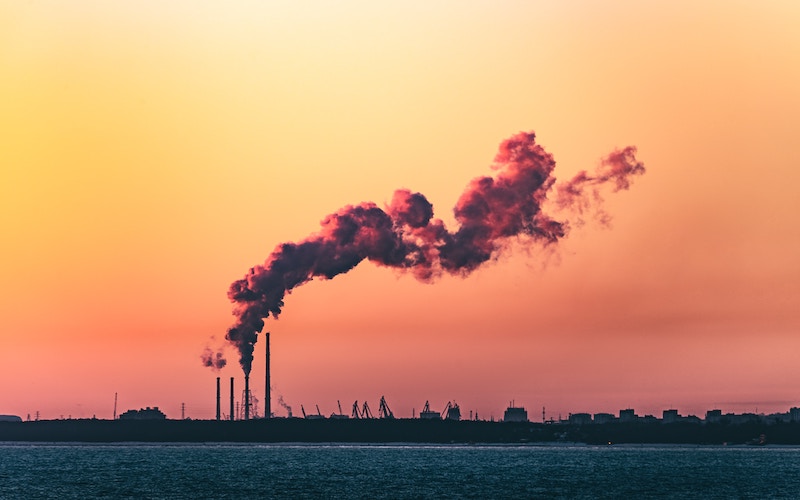
The textile industry is a giant. It influences not only our culture and aesthetics, but also our economy. For all the bright colours and fashionable styles the industry produces, it often leaves behind a grey shadow that manifests itself in the form of climate change. The growing production and consumption of textiles is driving the transgression of planetary boundaries (Planetary Boundaries).
Planetary Boundaries
The concept of Planetary Boundaries was developed to define a "safe operating field" for humanity on Earth. This theory identifies nine critical systems that affect the stability and resilience of our planet. Each of these boundaries is associated with a "threshold limit" that, if crossed, can lead to irreversible and often catastrophic changes in the functioning of the Earth system.
The idea of planetary boundaries was first put forward in 2009 by Johan Rockström and a team of international scientists and has been refined in further work (Rockström et al., 2009; Steffen et al., 2015).
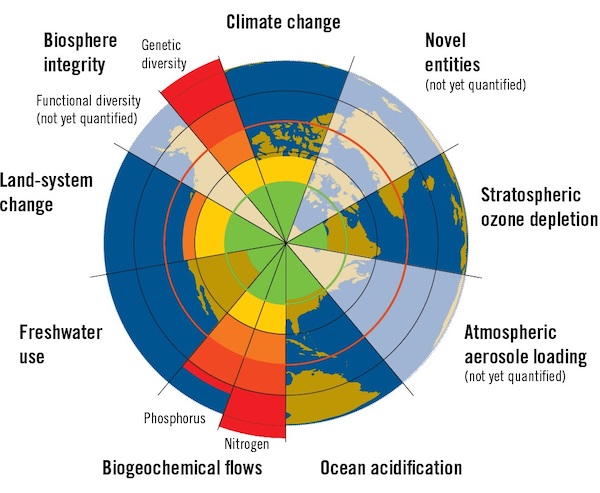
Planetary boundaries (after Steffen et al.)
The nine Planetary Boundaries are (counter-clockwise in the diagram):
1. Climate Change
This refers to the concentration of greenhouse gases in the atmosphere that is driving global warming. Exceeding this could lead to destabilising changes in the climate system
2. Biosphere integrity (loss of biodiversity)
The rapid loss of species, mainly through human activities such as land use and pollution, affects the ecological stability and function of ecosystems.
3. Land-system change
Conversion of natural ecosystems to agricultural or urban areas affects biodiversity and can lead to soil erosion and degradation.
4. Freshwater use
Overexploitation of freshwater resources for agricultural, industrial and domestic purposes threatens to deplete water supplies in many regions of the world.
5. Biogeochemical flows (nitrogen and phosphorus cycles)
Excessive use of nitrogen and phosphorus in agriculture leads to eutrophication of aquatic ecosystems and can significantly harm aquatic life.
6. Ocean acidification
The uptake of CO2 from the atmosphere by the oceans leads to acidification, which affects marine ecosystems and specifically calcifying organisms such as corals.
7. Atmospheric aerosol loading
Aerosol emissions from human activities affect both local and global climate and can impact human health.
8. Stratospheric ozone depletion
The depletion of the stratospheric ozone layer by chemical compounds such as CFCs impairs the Earth's natural UV protection, which can lead to health and environmental problems.
9. Novel entities
This refers to chemicals, nanomaterials and other man-made substances that could have potentially harmful effects on the Earth.
The Planetary Boundaries and the Textile Industry
The textile industry is at a critical juncture where it has huge implications for both the economy and the environment. The growing production and consumption of textiles is driving the crossing of Planetary Boundaries, a concept that identifies nine global priorities within which humanity can safely operate (Steffen et al., 2015). In this comprehensive blog post, we would like to discuss the impact of the textile industry on these Planetary Boundaries and highlight the urgent need for sustainable transformation.
Climate change
The textile industry is responsible for about 1.2 billion tonnes of CO2 emissions per year, accounting for about 10% of total industrial CO2 emissions (Ellen MacArthur Foundation, 2017). The use of fossil fuels in the production and transport of textiles increases the concentration of CO2 in the atmosphere, which accelerates global warming. Global greenhouse gas emissions from the textile industry are higher than everything caused by international flights and international shipping combined. In the European Union, private consumption of textiles is the fourth largest polluter (after food, housing and transport), according to Greenpeace. But even here, not every fibre should be considered the same. Organic cotton, for example, actually has negative emissions at the fibre level because the plant binds CO2. However, with the madness of the fast fashion industry worldwide, we are on a path to more and more CO2 emissions in the textile industry.
The European Commission's report on the carbon footprint of the textile industry is a good example of this.
The European Commission states in its EU Strategy for Sustainable and Recyclable Textiles:
"Global textile production almost doubled between 2000 and 2015 and consumption of clothing and footwear is expected to increase by 63% from 62 million tonnes today to 102 million tonnes in 2030." (source)
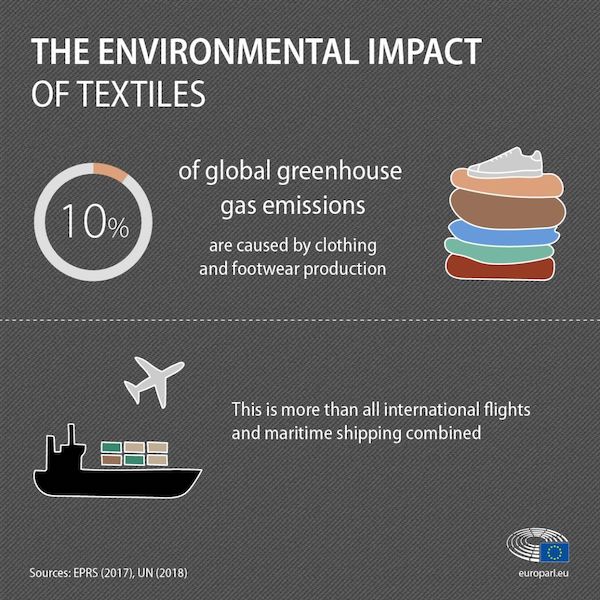
Water use
Water use in the textile supply chain is a critical factor stressing planetary boundaries in terms of the global freshwater budget. Water is required in almost every step of the textile production chain, and the impacts are far-reaching
Fibre cultivation / fibre production
The first step in the textile supply chain is the cultivation of fibres such as cotton. Especially the conventional cultivation of cotton with uncontrolled irrigation uses an extremely large amount of water. The cultivation of organic cotton, on the other hand, should be viewed in a differentiated way, as we have explained in more detail here in our blog post on the topic of organic cotton and water. Cotton is always listed as the largest consumer of water, however this consideration is misleading when cotton is irrigated with rainwater and the natural cycles of the weather.
Here we need to look more closely at the "type" of water. Water use analysis often distinguishes between three different types of water: green, blue and grey. Here is a brief explanation:
- Green water: This refers to the water stored in soil moisture that plants lose through transpiration and evaporation. It is essentially rainwater used directly by plants.
- Blue water: This refers to surface and groundwater that is stored in larger quantities in reservoirs or diverted for irrigation systems. It is the water withdrawn from rivers, lakes or groundwater reservoirs by human activity.
- Grey water: This refers to the water needed to dilute or purify polluted water. It is basically the water needed to treat wastewater generated by production and consumption.
The production of synthetic textile fibres such as polyester, nylon and acrylic, on the other hand, has a significant impact on "blue" water consumption. Synthetic fibres are mainly derived from petroleum. The petroleum extraction process itself requires a lot of water, both for drilling and for processing the crude oil. Polymerisation, the process by which the base materials are turned into synthetic fibres, also requires water, mainly as a coolant and solvent for chemical reactions. In the later stages of production, the fibres are textured and pushed through spinnerets. Both processes can be water-intensive, especially considering that the fibres often have to be treated with chemical solutions that subsequently have to be removed from the wastewater.
So, that (organic) cotton is the biggest consumer of water at the fibre level is a myth. It is important to look at exactly which fibre is involved in order to analyse the water footprint and the burden on the planetary boundaries. If we also consider that more than 60% of all fibres produced worldwide today are synthetic fibres, the water consumption is proportionally much higher.
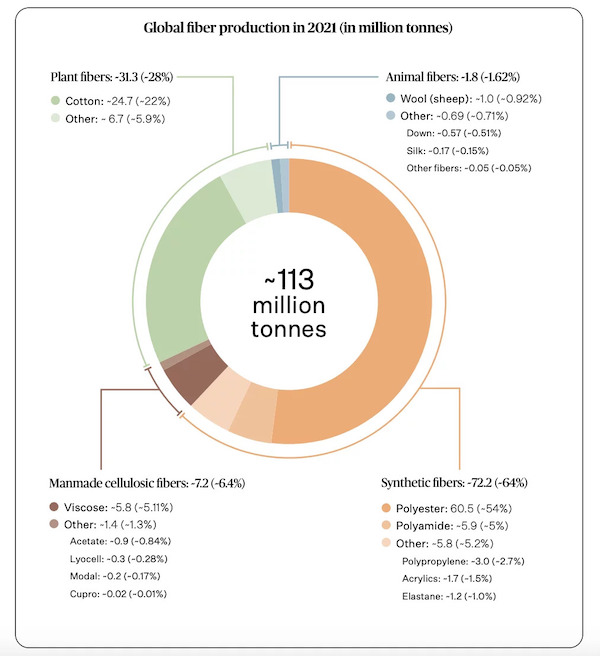
Dyeing and finishing
In the dyeing and finishing process, large amounts of water are needed to bleach, dye and treat fabrics. This water is often contaminated with chemicals and, if not properly treated, can be discharged into local waterways, causing pollution and degradation of aquatic ecosystems. The textile industry contributes to 20% of global water pollution, an amount that would be enough to supply 110 million people with drinking water for a year! The negative impact of textile production on our water ecosystems is shown in this Deutsche Welle clip "How our clothes cause water pollution"
End usage
Finally, water is also consumed in the washing and care of garments by the end consumer. Often garments are made of cheap material that are not durable and need to be washed more frequently, which further increases water consumption. The water consumption of a washing machine per wash cycle, for example, also varies depending on the model and the programme selected. While older appliances that are 20 years old or more can use up to 200 litres per cycle, modern washing machines are equipped with water-saving features and can reduce consumption to less than 35 litres.
Chemical pollution and land use
With the use of pesticides in cotton production and the use of chemicals in textile dyeing, there are serious problems of chemical pollution. This not only affects people's health, but also biodiversity. Toxic chemicals can enter water bodies and soil, affecting both aquatic and terrestrial ecosystems. For example, azo dyes used in the textile industry can release aromatic amines when they break down, which can be carcinogenic. In addition, many of these chemicals are resistant to biodegradation and can accumulate in the environment. This has long-term effects on biodiversity and human health. Microplastics, as polluters of the world's oceans and aquatic systems, should of course also be mentioned here.
An overview of hazardous chemicals in the environment.
An overview of hazardous chemicals that are unfortunately still used uncontrolled in the textile industry can be found here at Greenpeace.
Land use
The textile industry also has a very strong impact on the issue of land use. In particular through the cultivation of cotton, but increasingly also through the use of so-called MMCF (Man-Made-Cellulosic-Fibre), i.e. artificial cellulose fibres made from wood. In 2022, the non-governmental organisation Canopy Planet reported that about 70 million trees have been cut down globally for the production of textiles. The organisation predicts that this number is likely to double in the next two decades. Canopy's research indicates that the textile industry often uses wood from endangered forest areas. In particular, viscose and similar materials such as rayon and modal are increasingly produced from wood from some of the world's most endangered forests, including the rainforest in Indonesia and the boreal forests in the far north. This leads to extreme land-use conflicts. The activities of the fast fashion industry lead to soil erosion, land degradation and loss of natural habitats. In Canopy's Hot Button Report, you can see which fibre manufacturers are particularly unscrupulous and which fibre manufacturers are among the good guys (the Lenzing company from Austria, for example).
Conventional and intensive cotton production is particularly problematic, as it not only requires large areas of land, but also consumes significant amounts of water.

Conclusion:
There is an urgent need for action to reduce the negative impacts of the textile industry on planetary boundaries, particularly in the areas of chemical pollution and land use. Environmentally friendly innovations in textile manufacturing, processing and recycling can help minimise these impacts and accelerate the transition to a more sustainable textile industry. The use of certified textiles, e.g. natural textiles produced according to the Global Organic Textile Standard (GOTS), make an important contribution to not exceeding planetary boundaries.
This is very evident from the fact that textiles are produced according to the Global Organic Textile Standard (GOTS).
This can be seen very clearly in the example of organic cotton. But new, innovative recycled fibres or sustainably produced cellulose fibres can also take pressure off ecosystems and reduce the textile industry's contribution to climate change. At the end of the day, as with all things, less of the good is better than too much of the bad!
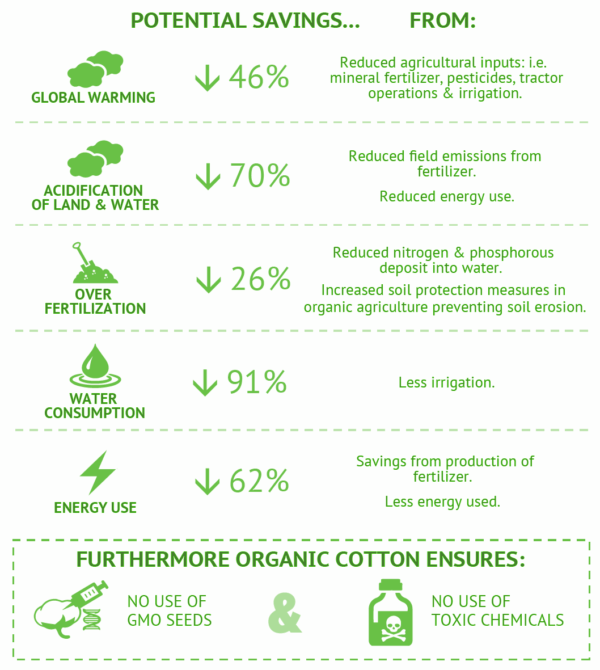
Necessary steps for a sustainable transformation
- Transparency and traceability: consumers should be able to track the entire supply chain of a product
- Certifications: Labels such as GOTS (Global Organic Textile Standard) can help consumers make more sustainable choices.
- Recycling and circular economy: Establishing systems for recycling textiles and the circular economy.
- Technological innovation: Advances such as waterless dyeing techniques or the use of sustainable materials can make a huge difference.
- Policy framework: Strong regulations and incentives are needed to encourage industry to adhere to sustainable practices.
The transgression of planetary boundaries by the textile industry is a serious matter that requires immediate attention. Through a combination of consumer education, technological innovation and policy regulation, we can hopefully create a more sustainable and responsible textile industry.
Sources:
Steffen, W., et al. (2015). "Planetary boundaries: guiding human development on a changing planet." Science, 347(6223).
Rockström, J., et al. (2009). "A safe operating space for humanity." Nature, 461(7263), 472-475.
Ellen MacArthur Foundation. (2017). "A new textiles economy: redesigning fashion's future."
WWF (2013). "The Impact of Cotton on Freshwater Resources and Ecosystems."
Mekonnen, M. M., & Hoekstra, A. Y. (2010). The green, blue and grey water footprint of crops and derived crop products. Hydrology and Earth System Sciences.
UN Environment Programme. "Sustainable Fashion: How to Make It a Reality."
Ellen MacArthur Foundation. (2017). "A new textiles economy: redesigning fashion's future."
Water Footprint Assessment of Polyester," Water Footprint Network
Shen, Liwen, et al. "Environmental impact of polyester and other synthetic fibres," Journal of Cleaner Production, 2017.
"The Hidden Cost of Water Use in the Textile Industry," World Resources Institute Report, 2019.
Global Organic Textile Standard (GOTS)
Cover photo by Marek Piwnicki via Unsplash

